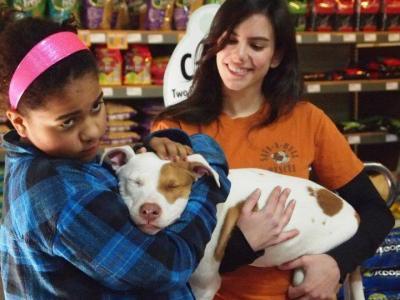When I was bitten by a dog at 8 years old, my prize was 23 stitches in my face and neck. As I will explain, the dog breed does not matter, but the dog in question was not a pit bull. Six years later, my family brought a puppy into our home. Growing up, if you had asked my brothers and me who our favorite sibling was, we would have unanimously answered Abby, our family dog. Sharing your childhood with a dog can be a magical experience, and one that I hope my future kids will experience. But when it goes wrong, it can also be a heartbreaking one.
I was thrilled to see HuffPost Green's #pitbullweek tackling myths that plague pit bull-type dogs. These myths directly harm families with pit bulls, making it unfairly difficult for responsible dog-owners to find housing or insurance. It also directly harms families that don't have pit bulls. When we attribute characteristics to pit bulls generally associated with aggressiveness, we unintentionally create the perception that other types of dogs are completely safe. And the truth is, any dog can bite. Community and personal safety depends on treating every dog as an individual. The safety of children raised with dogs depends on recognizing stress signs in dogs, teaching children appropriate ways to bond with a dog, and actively supervising interactions between children and dogs.
In my practice as a behavior consultant, I have too often heard parents say, with anguish in their voices, that the dog bit and, "He just didn't give any warning." Unfortunately, it does not relieve any pain to explain that the dog gave a warning, but it went unnoticed. Dogs do give us many signs that they are uncomfortable. If subtle body language is not recognized, the dog will eventually feel like he has no choice but to intensify his communication. What started as a polite request for space can escalate into a bite. In the HuffPost Green video of children and pit bulls, I saw signs of lovely relationships between the dogs and the children, but I also saw many concerning interactions that should have warranted immediate parental intervention.
So, what are the subtle signs that your dog is stressed about an interaction?
- The dog is turning his head away
- The dog is licking his lips (but there is no food present)
- The dog's posture is stiff
- The dog is raising a paw
- The dog's eyes are wide and the whites may be visible
- The dog is trying to walk away or avoid the child
What are good guidelines for teaching children to interact with dogs?
- The dog should solicit attention from the child - the child should never pursue the dog for an interaction
- The dog is not a toy, not a horse to be ridden, and not a mountain to be climbed
- One hand for petting the dog is enough, two hands are too much -- and please, no hugging
- Pet for 3 seconds, and then pause and see if the dog actively asks for more petting, or decides to walk away
- Children should pet the shoulder of the dog, not the head, which most dogs don't like (If you're an adult, try reaching out to pet your dog on the top of his head -- does he duck? Most dogs do -- they just do not care for pats to the head.)
- Dogs deserve their own space while they're eating, napping, or chewing on a toy
The best way to keep kids and dogs happy and safe is through active and engaged adult supervision. Parents can give children proactive guidance on how and when to interact with their dog. They are also available for a swift intervention if the dog begins to look uncomfortable. If a work email or dinner on the stove is begging for attention, separate the child and dog.
Armed with your new knowledge, what to do if you notice that there are a lot of stressy, uncomfortable interactions between your kids and your dog? You are keeping everyone safe, but it does not seem that they are all as happy as they could be. Fortunately, there are training and behavior exercises that help kids and dogs repair and rebuild relationships. The exact approach will vary based on the history of interaction, behavior of the dog, and age of the child, so seeking professional help will ensure the ideal approach and make sure everything goes on without a hitch.
Here's to celebrating brothers and sisters -- canine and human -- and giving everyone the love and respect they deserve!
For the parent looking for more information, DogGoneSafe.com and FamilyPaws.org are excellent resources.
Originally posted on the Fetch Dog Training blog.
